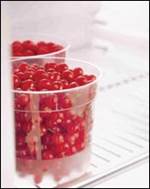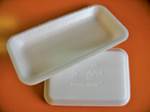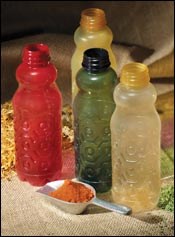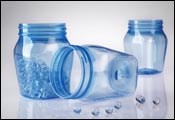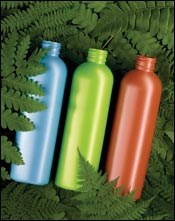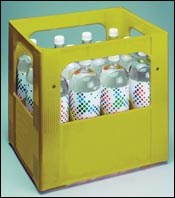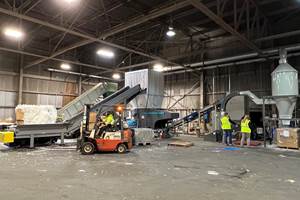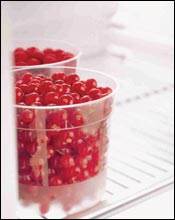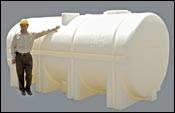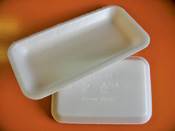Additives and Colorants Score Dramatic Advances
Among the host of new additives at K 2007 were a number of unusual entries: additives to add scratch resistance or reduce odor, leaps ahead in PP clarifying, specialized antioxidant protection for nanocomposites, a growth enhancer for greenhouse films, and a naturally free-flowing TiO2. In addition, “Green” was the theme of exhibits that highlighted “all-natural” additives for biopolymers, and colors to enliven recycled resins.
PLA GETS A BOOST
Biobased and biodegradable polylactic acid (PLA) is arousing considerable interest among processors and end users looking for eco-friendly plastics. PLA is stiff, strong, and clear, but it suffers from several innate deficiencies. It is brittle and has low heat resistance. In processing it has low melt strength and high sticking tendency. PLA also degrades easily during processing, and it degrades even faster in the presence of moisture, so predrying is necessary.
Two firms showed new products that address some of these limitations. Arkema and Clariant both introduced solutions to the problems of poor melt strength and melt stability. Arkema launched its first additives for PLA (though not themselves based on biopolymers), called Biostrength. Adding 4% of Biostrength 700 processing aid doubles the melt strength of PLA while maintaining full transparency. It has the same effect on PLA with 75% regrind—the melt strength is double that of virgin PLA. That assists recycling and also minimizes the need for predrying, Arkema says. Improved melt strength and melt elasticity provide a wider processing window for extrusion, reduce parison thinning in blow molding, assist deep-draw thermoforming, and provide a more consistent cell structure in foams.
Similar claims are made for a Clariant additive masterbatch called CESA-natur, using a chain extender called CESA-extend that has been shown to re-link polymer chains broken by degradation in reclaimed PET and nylon. Now, Clariant reports that it works in PLA. CESA-natur reportedly improves PLA melt strength, allowing larger and more stable film bubbles during extrusion, even at higher line speeds, and also produces smaller and more resilient cells in foamed PLA sheet (see Learn More).
Arkema also addressed the brittleness of PLA with two new impact modifiers based on familiar core-shell technology. Biostrength 130 is an acrylic modifier that retains adequate transparency for translucent applications. Biostrength 150 is an MBS-type modifier that provides greater toughening but only for opaque applications. Adding 2% of either modifier to neat PLA with 0.44 ft-lb Gardner impact approximately doubles the impact level. At 7% addition, Biostrength 130 provides about 1.85 ft-lb and Biostrength 150 gives around 2.8 ft-lb. At 10% loading, Gardner impact is roughly 6 and 8 ft-lb, respectively.
ADDITIVES FOR OLEFINS
One of the most significant additive introductions for polyolefins at the show was Milliken’s latest PP clarifier, Millad NX8000. It is said to set a new standard for PP clarity and to provide higher clarity in thicker sections than ever before. It is said to produce 50% less haze at any part thickness than Milliken’s previous benchmark clarifier, Millad 3988i. Haze reduction is also independent of resin type (homopolymer or random copolymer) and MFR. This third-generation sorbitol acetal clarifier melts at a lower temperature than Millad 3988i, allowing easier compounding. Typical use level is 4000 ppm (0.4%).
Meanwhile, Ciba Specialty Chemicals launched its own PP clarifier, Irgaclear XT 386, based on new trisamide chemistry. It is said to match the clarity of Millad 3988i but at use levels only one-twelfth as high (just 150 ppm), leading to improved taste and odor, Ciba claims. XT 386 reportedly also has improved regrind stability and lower plateout. Its nucleating properties also provide cycle-time reductions.
Milliken also had news in nucleation—for PE. Its latest nucleant, Hyperform HPN-20E, was originally introduced at NPE 2006 for boosting clarity in HDPE blown film. More recently it has been shown to cut cycle times in rotomolding (see Learn More) and is being tested in other processes. For example, injection molding trials reportedly showed a reduction in cooling time for an HDPE crate from 23 sec to 17 sec on a 45-sec total cycle. In HDPE blow molding, this nucleant shows promise in reducing cycle time and controlling warpage and shrinkage. Unlike PP nucleants, it is said to reduce shrinkage in HDPE. That could mean faster blowing of bottles without neck ovalization. Milliken will also investigate its effect on cell-size control in rotomolded foams.
What’s said to be the first-of-a-kind “anti-scratch” additive for PP and TPO was also introduced by Ciba. Irgasurf SR 100 is a polymeric material added at 1% to 3% to boost scratch resistance in auto exterior and interior parts. It’s also said to raise impact strength. The product can be added directly at the molding machine and reportedly does not interfere with colorants or light stabilizers, nor does it cause exudation or stickiness, Ciba says.
Another unusual product is Ciba’s new Smartlight RL 1000, a red luminescent additive for greenhouse films that is said to cause roses to grow up to 37% faster and with longer stems. Adding 0.5% to 2% of this red powder to PE, PP, EVA, or EBA films causes them to absorb part of the UV spectrum and re-emit it as red light, which influences plant growth. It reportedly functions well even in cloudy weather.
If odor is a problem, as it can be for polyolefins in auto interiors, a new polymeric stripping agent from Byk-Chemie could be the answer. Made by adsorbing an aqueous solution of this agent onto a PP carrier, Byk-P 4200 is added in the compounding operation, and it carries away odor-causing contaminants and VOCs during vacuum degassing. It’s recommended at 0.5% to 2% in PP and can also be used in PE.
A developmental polyolefin elastomer (POE) can be used to formulate TPOs or as an extender for SEBS. ENR 7487.00 is the newest member of Dow’s family of high-melt-strength POEs (called Engage when commercial) that can make TPOs for sheet and profiles and thermoforming. This is the softest (58 Shore A) of four grades developed so far. It is said to provide exceptionally low gloss.
Baerlocher, a supplier better known for PVC additives (see sidebar), has come out with lubricant one-pack systems for polyolefin wood/plastic composites (WPCs). They are said to improve stability, consistency, output rate, and energy consumption and also to reduce water absorption. Baerolub W Series one-packs are based on metallic stearates. Baerolub WPT and EW series are for use with coupling agents, which can interfere with lubrication.
ANTIOXIDANTS & UV
Ciba addressed the nascent field of nanocomposites with new Irgatec NC 66, a mixture of phenolic and other antioxidant functionalities plus calcium organic salts and metal oxides. It is specially designed to improve heat stability of nanoclay compounds during processing, allowing them to run faster and hotter. It reduces odor during processing, retards age yellowing, and boosts long-term heat and light stability.
Also new from Ciba is Irgastab FS 533, a phenol-free stabilizer for PP fibers that employs new chemistry to prevent gas fading and improve long-term heat and UV stability in carpets, upholstery, and geotextiles. It also has low peroxide interaction during “visbreaking.”
And as reported in December (see Learn More), Ciba also brought out Tinuvin PUR 866, a blend of HALS and other ingredients that provides outstanding initial color and prevents long-term yellowing in clear TPUs for sports and leisure products.
Korea’s Songwon Industrial came to the K Show seeking a higher profile among global stabilizer suppliers. It has introduced some 30 new products since 2006, including phosphite, thioester, and phenolic antioxidants and benzotriazole, benzoate, HALS, and nickel-based light stabilizers. Here are some of the most recent entries:
- Songnox 2500 is a hydroquinone-based phenolic antioxidant and anti-scorch agent for wire and cable.
- Songnox 4425 is a cresol-based phenolic antioxidant for nylons, polyesters, HIPS, and ABS. It’s a powder and is said to provide very low color, low volatility, and high solubility.
- Songnox 6180 is a phosphate antioxidant for ABS and LDPE/LLDPE films. It’s said to provide outstanding color suppression.
- Songsorb 3600 is a UV absorber for PC, boasting high MW, low volatility, and high activity.
- Songwon is also introducing one-pack stabilizer systems (OPS) that are low-dust, free-flowing granules made by compaction with no resin carrier. It teamed up with W. Zink GmbH to produce OPS for Europe and it is seeking a North American partner.
NEW FLAME RETARDANTS
Songwon introduced three new types of halogen-free flame retardants for thermoplastics and thermosets. Songflame TP-100 is a phenol/biphenol polyphosphate for PC, PC/ABS, PPE/PPO-based resins, and TP polyesters. It comes in a convenient solid form (unlike many other phosphorus FR agents) and its high glass-transition temperature leads to improved HDT in resin compounds. It is also said to be chemically stable, low in toxicity, and environmentally safe.
For epoxy circuit boards, new Songflame YA 010 and YA 020 are reactive additives (trifunctional and bifunctional, respectively) based on phosphine oxides. These high-MW products are highly soluble in epoxy. They latch onto the polymer backbone and are said to be noncorrosive, nontoxic, and environmentally safe.
Another new nonhalogen FR additive for PET and PBT electronic equipment comes from Clariant’s Pigments & Additives Div. Exolit OP 1240 is a metal phosphinate that is nonmelting and can be used on its own or with nitrogen synergists such as melamine. The product has the benefits of low use level (15% to 22% for UL 94V-0 at 0.8 mm), low compound density, good compound mechanical and electrical properties (CTI >500 V), and colorability.
Several new products were unveiled by Albemarle Corp. One is a developmental dust-free pellet form of its Saytex 8010 aromatic bromine compound for styrenics and nylons. The pellet is said to disperse better, with less mixing energy, allowing higher throughput and providing better physical properties in the compound. FR performance is said to be unchanged. Pellets reportedly also result in less waste, since an average of 0.6% of the contents of a 25-kg bag of the powder form typically remains behind. (Albemarle will bring on additional capacity for Saytex 8010 this year.)
Also new from Albemarle is Martinal LEO, a new form of precipitated alumina trihydrate aimed at LLDPE/EVA wire and cable. “LE” stands for “low electrolyte” and “O” means “optimized.” A new method of precipitation is results in a new particle form that reportedly compounds faster and more easily. In the past, uneven feeding and limitations on wettability were problems in compounding at very high output rates. The new uncoated particle form is said have better bulk flow than previous LE grades, produce lower viscosity in compounding, and exhibit higher thermal stability. It also boats lower water pickup and better electrical properties.
Albemarle announced four new Antiblaze liquid phosphate flame retardants for polyurethanes, which will be covered next month in an report on PUR machinery and materials developments at K 2007.
COLORS GO ‘GREEN’
Clariant’s new Renol-natur color masterbatches are designed for all types of biopolymers (PLA, PHA, and starch-based) and contain only natural and renewable and completely biodegradable resins and colorants, the company says. Derived mainly from plants, the colors include red, orange, yellow, and green; blue is in final stages of development. Orange is derived from the root of the turmeric spice plant. Yellow comes from a tropical flower, green from chlorophyll and other plant sources, and carmine red from the cochineal insect. Some of them boast excellent clarity, but their lightfastness may be limited.
In addition, Clariant came out with new Enigma color and effect masterbatches aimed specifically at bottles using high levels (up to 100%) of post-consumer recycled (PCR) HDPE. These recycled resins often have a grayish cast that mutes coloration, so packagers have commonly restricted the level of PCR to 25% or less. The new family of Enigma products is designed to produce bright, appealing colors with high PCR levels. “Light on Water” is a translucent blue with large pearlescent flecks. “Cayenne Fire” is a fiery red pearl. And “Green Apple” is a vibrant green pearl.
FREE-FLOWING TIO2
The K Show proved it’s still possible to achieve something new and unusual in titanium dioxide pigments. Huntsman Pigments (Tioxide America in the U.S.) describes its new Deltio 5X product as “a revolutionary low-dust TiO2 that has handling properties far superior to any TiO2 currently available for plastics compounders.” It has been used in extensive trials at Swedish masterbatch producer Delta Plast, part of the A. Schulman group. Deltio 5X increased output rates by 20% to 25%, according to production manager Marcus Persson. “It’s more free-flowing in the hopper, so it’s easier for the machine to taken in the material and extrude it,” he said.
The non-bridging, non-sticking, and low-dusting performance of this pigment is not achieved with a coating but by modifying the pigment particles so that they clump together in larger agglomerates in “dry” form but separate easily to provide unimpeded dispersion.
Deltio 5X reportedly does not compromise any of TiO2’s optical properties. Users get easy flow without agitation, less sticking to hopper and silo walls, easier cleanout, and more precise metering, thanks to a ±10% variation in flow rate rather than the usual ±50% variation. Deltio 5X is priced above standard grades. Only one g-p grade is now offered, but a broad family is planned. Deltio was initially produced only in the U.K. but Hunstman plans to start production here in this first quarter.
NON-WARPING PIGMENTS
Ciba and Clariant launched yellows and reds based on new color chemistries and several new non-warping pigments for HDPE. Ciba’s Cromophtal Yellow 4GV is a new type of organic green-shade yellow (Pigment Yellow 215) with very high color strength and excellent heat and light stability, even at shading concentrations. It is also FDA listed and non-warping in HDPE—reportedly a first. It is recommended for polyolefins and nylon and is also available as Microlen Yellow 4GV-PG predispersed polyolefin pellets. Ciba says an HDPE crate that normally has a 36-sec injection molding cycle can now be ejected hotter but warp-free with this new pigment, shortening the cycle time to 33 sec.
This product embodies what Ciba says is a new and unique technology for modifying pigment particles so that they have less warping effect in HDPE. This technology has been applied to other Microlen dispersions of organic pigments—Yellow 3RLW-PG, Blue GBLW-PG, and Green GFLW-PG—and it could be applied to even more in the future. Ciba says this technology allows those pigments to be used in applications where they could not be used before.
Another new non-warping pigment, which is also said to be a unique yellow-shade red, is Ciba’s Cromophtal DPP Red TFP. It offers high strength, excellent dispersibility, and a brilliant, saturated, transparent tone that offers interesting potential in combination with effect pigments.
We reported last October (see Keeping Up with Additives) on Ciba’s new Xymara Nordic pearlescent pigments with brilliant glitter and frost effects. Now Ciba offers Xymara mica-based pigments in a low-dusting predensified form, the Xymara MC series, for polyolefins.
Another new low-dust product is Ciba’s Microlen MP pigments. These are polyolefin dispersions in free-flowing micro-granules. The pigments are less finely dispersed than in Microlen MC products, thus making them less expensive for general-purpose use.
Clariant Pigments & Additives Div. offers two new low-warping pigments. One is a DPP type, PV fast Red D3GW, with excellent dispersibility and color-fastness. The other is a brand-new azo color chemistry (Pigment Red 285), called PV Fast Red HGR. It boasts high color strength and fastness and excellent dispersibility.
Also new from Clariant is a way of custom-coloring acrylic capstocks for vinyl building profiles to permit easy color changes to keep up with customer tastes. Its Hostacryl pigment preparations are very small beads containing 60% organic pigment. They are said to be free-flowing, easy-processing, and very UV stable.
The news from Clariant Masterbatches includes Enigma High Contrast special-effects concentrates that use reflective elements that stand out from the base color. This effect is achieved by pairing complementary colors, warm and cool colors, or aggressive and recessive shades.
Clariant also offers new Renol colors designed for PC/ABS appliances and consumer electronics. These combine color with flame retardants and UV stabilizers so as not to compromise those properties of the base material.
Merck (parent of EMD Chemicals in the U.S.) added three new colors to its Miraval interference pigment line, which are said to add sparkling luster and glittering highlights. They are based on synthetic borosilicate flakes with particle sizes of 10 to 100 microns. The three new grades are Miraval Scenic Gold, Scenic Copper, and Scenic Turquoise.
MORE NEW ADDITIVES
Cyclics is a U.S. firm with a unique technology for producing low-melting, low-viscosity oligomers that can be catalyzed to cure when heated into a standard PBT engineering resin. At K, it showed off two additive uses for its “CBT” material when formulated without catalyst so that it does not cure. One application is a masterbatch carrier: Its low viscosity allows it to wet out high loadings of pigments, fillers, flame retardants, etc. CBT 100 reportedly is compatible with a wide variety of resins and is heat stable at up to 644 F.
Another use is as a flow enhancer for PET, PBT, acetal, nylon, polyolefins, PPE, PVC, ABS, SAN, acrylic, or TPEs. CBT 100 reportedly enhances flow with minimal effect on mechanical properties—it even boosts impact strength. It also retains clarity in PC. Cyclics says CBT 100 aids mold filling, reduces stresses that cause warpage, permits higher filler or glass loadings, decreases energy consumption, and allows lower processing temperatures. Up to 3% in PET, PBT, and PETG is FDA-compliant for aqueous and low-alcohol food contact.
A polymeric processing aid for filled thermoplastics was introduced by Byk-Chemie. Byk-P 4101 is an acid-functional copolymer on a silica carrier. It provides filler coupling for better flow and mechanical properties—especially in PE, PP, and nylon, though it also can be used in ABS and PVC. Use levels are 0.25% to 1.5%.
Byk’s new Disperplast-1018 is a wetting and dispersing aid for color masterbatches. This highly functionalized copolymer is low melting, so it can wet out the pigment before the polymer matrix melts. It is recommended for PE and PP but also can be used in PS, ABS, or nylon.
New from DuPont are two Entira permanent antistats for polyolefins and other resins. Like the existing DuPont Entira Antistat MK 400, new Entira AS SD 100 and Entira AS 500 are very hygroscopic ionomer resins that are used at 10% to 20% levels to provide non-migratory, non-yellowing static protection for anything from cosmetics packaging to sensitive electronics. They are said to provide transparency and printability without die build-up, and they can be incorporated in a discrete layer of the product.
While all three Entira AS grades provide similar protection at 50% RH, the new grades are more effective at low humidity. New SD 100 grade provides the lowest resistivity in dry conditions—enough to protect electronics from sparks even at 10% RH—while AS 500 would be more suitable for keeping packaging dust-free at such low humidity. But SD 100, unlike the other two, is not processable at temperatures above 392 F. It does, however, meet FDA regulations, unlike AS 500.
Related Content
Processing Megatrends Drive New Product Developments at NPE2024
It’s all about sustainability and the circular economy, and it will be on display in Orlando across all the major processes. But there will be plenty to see in automation, AI and machine learning as well.
Read MoreHow to Optimize Injection Molding of PHA and PHA/PLA Blends
Here are processing guidelines aimed at both getting the PHA resin into the process without degrading it, and reducing residence time at melt temperatures.
Read MorePurpose-Built System Enhances Capacity and Flexibility for Recycler
A Boston recycler invested in a turnkey shredding, granulation and elutriation system to expand its plastics reclaim business.
Read MoreBreaking News From NPE2024
Here is a firsthand report of news in injection molding, extrusion, blow molding and recycling not previously covered.
Read MoreRead Next
New Additives and Colorants To Debut at K 2007
The world’s largest plastics show next month in Dusseldorf will highlight an unusual mix of new polymer additives, including some based on novel chemistries that reportedly set new levels of performance.
Read MoreAdvances in Materials, IML and Tooling Highlight Rotomolders' Meeting
Several new resins and additives that raise part performance and improve processability were launched at the recent 32nd Annual Fall Meeting of the Association of Rotational Molders (ARM) in Detroit.
Read MoreFoamed PLA Shows Promise In Biodegradable Meat Trays
Foamed food trays made of polylactic acid (PLA) resin, the corn-based biopolymer, have a commercial toehold in Europe and are undergoing market tests here.
Read More

